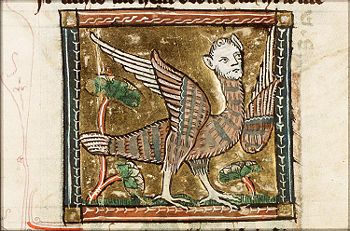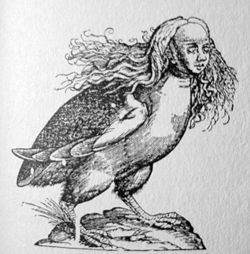Harpy

Harpy (from Latin: Harpyia, Greek: Άρπυια, Harpuia) in Greek mythology, the Harpies (snatchers[1] ) were mainly winged death-spirits (Harrison 1903, p 176ff), best known for constantly stealing all food from Phineas. The literal meaning of the word seems to be "whirlwinds."
The Harpy could also bring life. A Harpy was the mother by the West Wind Zephyros of the horses of Achilles (Iliad xvi. 160). In this context Jane Harrison adduced the notion in Virgil's Georgics that mares became gravid by the wind alone, marvelous to say (iii.274).
Though Hesiod (Theogony) calls them two "lovely-haired" creatures, Harpies as beautiful winged bird-women are a late development, in parallel with the transformation of the "Siren, a creature malign though seductive in Homer, but gradually softened by the Athenian imagination into a sorrowful death angel" (Harrison p 177).. On a vase in the Berlin Museum (Harrison, fig 19), a harpy has a small figure of a hero in each claw, but her head is recognizably a Gorgon, with goggling eyes, protruding tongue and fangs.
Mythology
The Harpies were sisters of Iris, daughters of Typhon and Echidna.
Phineas, a king of Thrace, had the gift of prophesy. Zeus, angry that Phineas revealed too much, punished him by putting him on an island with a buffet of food which he could never eat. The Harpies always arrived and stole the food out of his hands right before he could satisfy his hunger, and befouled the remains. This continued until the arrival of Jason and the Argonauts. The Boreads, sons of Boreas, the North Wind, who also could fly, succeeded in driving the Harpies and killing one of them, as a request from Iris, who promised that Phineas would not be bothered by the Harpies again, and "the dogs of great Zeus" returned to their "cave in Minoan Crete." Thankful for their help, Phineas told the Argonauts how to pass the Symplegades. (Argonautica, book II; Ovid XIII, 710; Virgil III, 211, 245).
In this form they were agents of punishment who abducted people and tortured them on their way to Tartarus. They were vicious, cruel and violent. They lived on Strophades. They were usually seen as the personifications of the destructive nature of wind. The Harpies in this tradition, now thought of as three sisters instead of the original two, were: Aello ("storm swift"), Celaeno ("the dark") — also known as Podarge ("fleet-foot") — and Ocypete ("the swift wing").
Aeneas encountered Harpies on the Strophades as they repeatedly made off with the feast the Trojans were setting. Celaeno cursed them, saying the Trojans will be so hungry they will eat their tables before they reach the end of their journey. The Trojans fled in fear.
Heraldry
In the Middle Ages, the harpy, often called the "virgin eagle," became a popular charge in heraldry, particularly in East Frisia, seen on, among others, the coats-of-arms of Reitburg, Liechtenstein, and the Cirksenas.
Theories of origin
R.D. Barnett suggests in "Ancient Oriental Influences on Archaic Greece" — an essay in The Aegean and the Near East, Saul S. Weinberg, ed. (Locust Valley, N.Y.,1956) — that the Harpies were originally adapted from the ornaments on bronze caldrons from Urartu:
- These made such an impression in Greece that they seem to have given rise to the siren type in archaic Greek art, and as they appeared to flutter at the rim of such noble cooking vessels, apparently gave rise to the familiar Greek legend of Phineus and the Harpies, who are thus depicted in Greek art. The very name of Phineus, the victim of their persecutions, may be nothing but a corruption of the name of a king of Urartu, Ishpuinish or Ushpina (ca. 820 B.C.E.), who was perhaps associated by the Greek merchants with these vessels [2].
Other scholars point out that this theory is based upon the idea that the Harpies were bird monsters with human heads, which was not true in the original myths.
In their winged human form, the Harpies are no different from a large number of Greek divinities and as such would not need a special explanation for how they came to be. The later bird composite form is considered by most authors to have been a confusion with an early depiction of the Sirens as bird women.
Harpies in fiction
The familiar figures of harpies, with their composite form and violent nature, are much employed in video games and other products of market-directed culture.
Harpies appear in Dante's Divine Comedy, in Canto XIII of the Inferno, where they hound suicides. They also appear, clearly in reference to Dante, in The Amber Spyglass, the third book of Philip Pullman's His Dark Materials, when Lyra and Will journey to the land of the dead to rescue Lyra's friend Roger. The harpies have their traditional Greek role of escorting the spirits of the dead in Pullman's book, and Lyra persuades them to help guide the dead out of limbo/hell to peace.
In William Shakespeare's "The Tempest," the spirit Ariel disguises himself as a harpy to deliver the message of his master Prospero.
In The Last Unicorn (film), a Harpy, captured by Mommy Fortuna, resembles a giant vulture with the breasts of a woman. The Harpy's name is Celaeno(spelled Celeno in this work), "The Darkness," a lesser known harpy of greek mythology. The Film is based on the novel The Last Unicorn by Award Winning Fantasy Author, Peter S. Beagle which features a more traditional harpy.
A Harpy guards the area above the volcano in the 8-bit computer game Magicland Dizzy.
Harpy is Monster in My Pocket #21. In the video game, they appear in threes at the stage 4 construction site.
In Warcraft 3, the expansion and World of Warcraft the harpies are a fierce and barbarous race living in tribes. See also Harpies at the Warcraft race page.
In the MMOG EVE Online, the Harpy is a so-called Assault Frigate for the Caldari race, designed as a very powerful railgun platform with strong defenses.
In the TV show Charmed Harpies are powerful female demons. The ones seen have dark skin and are dressed in black with long black talon like finger nails. They have super-strength and can shoot small energy blasts from their hands.
In the Yu-Gi-Oh! trading card game, there is a set of attractive harpy monsters known as "Harpie Lady," which originated from Mai Valentine's deck in the manga and anime. They were originally sex themed in the Japanese uncut versions.
In God of War, the Harpies are a small, frequently encountered enemy, and servants of Ares.
In Tiberian Sun, the Harpy is a light helicopter used by NOD.
In the PC game, Guild Wars Nightfall, the Skree are race of bird-people based on the Harpies.
In the Castlevania series of games (most notably Symphony of the Night and later installments following that games formula) Harpies often appear as enemies, usually in the Clock Tower area of the game.
In the Serious Sam series of PC and console games the Harpy appears throughout various stages of the game as a standard airborne enemy creature that slash and have a projectile attack.
In the PC game, King's Quest V: Absence Makes the Heart Go Yonder! King Graham encounters harpies on an island en route to Mordack's castle, Graham escapes being eaten by them when he plays a lyre for the creatures, whom then change their minds and fight over the instrument.
Harpies in reality
The American Harpy Eagle is a real bird named after the mythological animal.
Notes
- ↑ The unelided form arepuia is inscribed on a black-figured vessel in Berlin illustrated in Jane Ellen Harrison, Prolegomena to the Study of Greek Religion, 1903, fig.18. The major painted decor of the vase is the slaying of the Gorgon.
- ↑ Greek Mythology - Myths Concerning Aia
ReferencesISBN links support NWE through referral fees
Credits
New World Encyclopedia writers and editors rewrote and completed the Wikipedia article in accordance with New World Encyclopedia standards. This article abides by terms of the Creative Commons CC-by-sa 3.0 License (CC-by-sa), which may be used and disseminated with proper attribution. Credit is due under the terms of this license that can reference both the New World Encyclopedia contributors and the selfless volunteer contributors of the Wikimedia Foundation. To cite this article click here for a list of acceptable citing formats.The history of earlier contributions by wikipedians is accessible to researchers here:
The history of this article since it was imported to New World Encyclopedia:
Note: Some restrictions may apply to use of individual images which are separately licensed.
